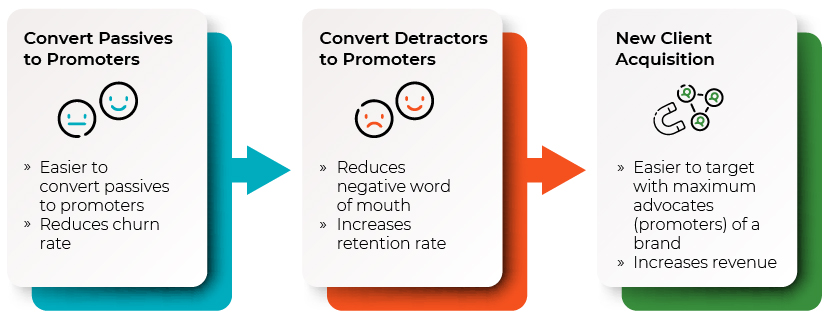Published on August 19, 2021 by Vandana Ahuja
Unlocking organisational success with the Voice of the Customer programme (an 8-part series)
This is part 7 of 8 our comprehensive series of blogs on the Voice of Customer.
Stay tuned for more blogs.
In part 6 of the series, we learnt in detail the processes of acting on Voice of the Customer feedback—closing the inner and outer loops. This blog talks about how the primary objective of closing the loop is to convert passives and detractors to promoters and the steps that need to be taken to realise this.
The primary focus of an organisation is to increase its revenue stream and keep growing. There are two ways an organisation can grow—customer retention and new customer acquisition. While acquiring a new customer would bring an additional revenue stream, it also involves greater expenses in the form of sales and marketing. On the other hand, renewals ensure continuity of existing revenue streams at no major additional marketing outlay, and new customer acquisition via referrals. An organisation is in a secure and comfortable position to expand its client base when the client churn rate is minimal.
Moreover, it would be harder to attract new customers unless most of the customers are brand evangelists of a company. This is where ‘promoters’—clients who help increase the customer base with their positive word of mouth—play a major role. However, till the time there are detractors and passives in the system, it is difficult to attract new clients. That is why converting detractors and passives to promoters is a key imperative for a business.
Along with understanding and acknowledging individual feedback, strategic changes to different areas, including, policies, pricing and resource allocation across an organisation, are required to change passives and detractors to promoters.
Focus areas for closing the outer loop: Converting passives to promoters, followed by converting detractors to promoters and then pitching new clients should be the order of action for a company looking to maximise confidence and trust. Though all three steps can be worked upon simultaneously, jumping directly to adding new clients might not be cost and time effective.

Converting passives to promoters
Passives are customers with a neutral point of view on a product or company. They might be using the product out of necessity. They do not find anything unique about the offering and might switch to a competitor for minor issues with an existing vendor or for additional value from a competitor.
Passives are often neglected by a company, though they can be assets, provided they are treated well. Since the passive score is close to a promoter score, it is easier to convert passives to promoters, and this can be achieved with improvements in one or two areas. For example, passives are sensitive to prices since they have neutral views of products. Companies need to be watchful of competitors’ offerings that could lure customers away easily. Additionally, a customer may only want an additional feature or a small tweak in a product to become a promoter.
How to strategise and execute this change is explained below:
1. Analyse all passive responses to identify core issues—Reach out personally if required, as passive clients may not be upfront with their issues. Communication needs to be transparent, with direct questions leaving no scope for neutrality, such as, “How can the company serve you better?” and “What additional features would you like to see in the product?”
2. Analyse the surveys and identify the possible churn reasons
3. Implement the required policy/strategic changes at multiple levels, including, pricing, resource allocation, product roadmap and customer support. Companies need to increase the perceived value of the product and make clients feel that there is something special/unique about the product/brand
4. Since some changes might be time consuming, notify clients through conferences and webinars about the weak areas that have been analysed and communicate that their issues are being addressed
5. Keep the stream of communication flowing through the top-down approach in each department
6. Build enthusiasm among employees at all levels to fulfil customer requirements
The changes required may include revising pricing based on competition, improving customer support, providing a user-friendly interface and adding some features that competitors are not offering.
Converting detractors to promoters
While it is comparatively difficult for a company to turn detractors to promoters in comparison to passives, it is more critical for the company’s success. Detractors are more likely to spread negative word of mouth among a greater number of people, which would harm a company’s reputation, while a happy customer would tell a lesser number of people about their delightful experience. According to a survey conducted by Inc.com on over 3,200 random consumers, 75% had indicated that they shared negative feedback or experiences as opposed to 42% of customers recommending a product or service they enjoyed.
The immediate impact of detractors on revenue is another reason why they should be taken care of by companies. Detractors are most likely to move to other products, affecting the revenue stream. On the other hand, once converted to promoters, they could bring revenue benefits to the business.
Detractors may also switch to another brand at the earliest opportunity. As per a study by PwC, one in three consumers (32%) is likely to walk away from a brand after just one bad experience. A high churn rate results in severe losses to revenue and profits.
Organisations need to work towards broader issues diligently to transform detractors to promoters. The seven-step process to plan and execute this change is explained below:
1. Gather all feedback – Usually, companies would find detailed feedback from the clients that are least satisfied. However, in case of a low score and lack of customer complaints, it is a company’s duty to reach out for detailed explanation of the issues. Customers appreciate the companies that seek feedback and act upon it.
2. Ensure quick turnaround – Detractors would usually switch within months; hence, it is crucial to find an immediate solution or keep them informed in case of long-term issues. Speak with the managers in case there are hindrances within the system and solve them at the earliest.
3. Empathise – Detractors seek support representatives who understand their problems and approach situations accordingly. Being courteous and showing empathy is something that they are looking for—human connection could bridge gaps.
4. Strategise and take action to close the loop – While acknowledging individual clients on their issues, changes should be enforced at the organisational level—leaders of different operations and services and the customer experience team need to take primary ownership. If a company is not able to fulfil the demands of customers, that should be communicated to clients with an alternative plan in place.
5. Learn from mistakes – Feedback from detractors is the ultimate source of knowledge for companies. Working on all the concerned areas in a timely manner could convert detractors to the biggest advocates.
6. Keep promises – Many companies overcommit as a measure to acknowledge a detractor, but companies should be honest with their client on commitments and deadlines and suggest the next best possible solution.
7. Keep following up with detractors – Often, companies think that following up with detractors is a waste of time, but that is not true. Many companies that follow up with detractors have increased customer retention, which is less expensive than targeting a new client.
While it is extremely important to work towards converting passives and detractors, companies should not forget to uplift promoters by saying “thank you”, providing occasional offers and discounts and maintaining healthy communication.
While dealing with all consumers, whether detractors, passives or promoters, it is vital to maintain a human connection with the client. Staff should build strong relationships with clients, make them believe that companies care about customer needs and preferences, their opinions are a priority and they are being provided an exclusive service and experience.
How Acuity Knowledge Partners can help
Acuity Knowledge Partners has been providing research and insight support to diverse stakeholders in the technology sector—tech corporates, tech advisory firms and tech-focused investors—for nearly two decades. Equipped with a 360o view, we understand how customer data can be captured and analysed, and how the story emanating thereof can be leveraged to achieve better business outcomes. We help Fortune 500 technology corporations, mid-tier firms, and start-ups leverage customer feedback on people, products and processes to remain flexible and better serve their customers.
References:
1. Experience is everything - Here's how to get it right, PWC, 2018
2. Acquiring Customers Isn’t Enough. Here’s Why You Need to Focus on Retention, Gainsight
3. How a Detractor Can Damage Your Company, Inc.com
4. 5 Ways to Turn Passives Into Promoters and Boost Your Net Promoter Score, Crewhu, Aug 2020
5. How to Connect With Passives and Turn Them Into Promoters, Retently, Aug 2019
6. Turn NPS Passives into Promoters: Top 5 Ways in 2021, Survey Sparrow
7. 6 Key ways to turn your detractors into promoters, Question Pro
Tags:
What's your view?
About the Author
Vandana Ahuja is part of the Private Equity and Consulting team in Acuity Knowledge Partners, Gurgaon. Currently working as a strategic consultant for a financial technology firm in the customer experience domain. She has over 10 years of experience in Strategic analysis, Business research and consulting.
She has diverse experience of working with top consulting companies across various industries and geographies. She has managed and executed various consulting projects involving competitor analysis, industry studies, company profiling, survey analysis and strategic recommendations, trend analysis, verbatim and sentiment analysis. She has managed various consulting clients.
She holds a degree in Master of Business Administration (M.B.A)..Show More
Like the way we think?
Next time we post something new, we'll send it to your inbox










